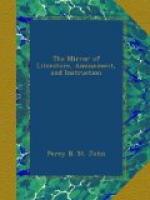Our Engraving is copied from the Gardener’s Magazine, where it is reduced from the Transactions of the Asiatic Society.
THE DEATHWATCH MAGNIFIED.
Although the present may be a late hour to dissipate the faith placed in signs and tokens, we are persuaded that a more intimate knowledge of this insect will not prove uninteresting to our readers.[3]
The name death watch was evidently derived from the importance attached to the beatings of the insect, which, by superstitious people, were formerly supposed to prognosticate death to some one of the family in whose house it was heard. The natural size of the insect is about a quarter of an inch in length, of a dark brown colour, spotted, with transparent wings under the vagina, or sheath, a huge cap or helmet on the head, and two antennae, or feelers, from beneath the eyes.
It is chiefly in the advanced period of spring that these insects commence their noise; and which is the call or signal by which they are mutually attracted to each other, and may be considered as analogous to the call of birds. This noise does not arise from their voice, but from the insect beating on hard substances, with the shield or fore part of its head. The general number of successive distinct strokes is from 7 to 9 or 11. These are given in pretty quick succession, and are repeated at uncertain intervals; and in old houses, where the insects are numerous, they may be heard, if the weather be warm, almost every hour in the day. The noise exactly resembles that made by beating moderately hard with the finger on a table. Mr. Stackhouse carefully observed its manner of beating. He says, the insect raises itself upon its hinder legs, and with the body somewhat inclined, beats its head with great force and agility against the place on which it stands.
This insect, which is the real death-watch of the vulgar, must not be confounded with another minuter insect, which makes a ticking noise like a watch; but instead of beating at intervals, it continues its noise for a considerable time without intermission. This latter belongs to a very different tribe. It is usually found in old wood, decayed furniture, neglected books, &c.; and both the male and the female have the power of making this ticking noise, in order to attract each other. The Rev. Mr. Derham seems to have been the first naturalist who examined and described this species; and he says that during the month of July, in one particular summer, they scarcely ever ceased to beat either in day or night. The eggs are generally hatched about the beginning of March: many of them live through the winter; but during that time, to avoid the frost, they bury themselves deep in dust.
Mr. T. Carpenter (of whose paper in Gill’s Repository we have already availed ourselves) tells us that these insects are excellent anatomists: in order to render them useful in making some delicate dissections for his microscope, Mr. Carpenter placed a few of the insects within a pill-box, with the heads of three dead flies. He found some time afterwards, that they had cleared the interior of some of the eyes completely from all the blood-vessels, leaving the lenses in the cornea beautifully transparent.




